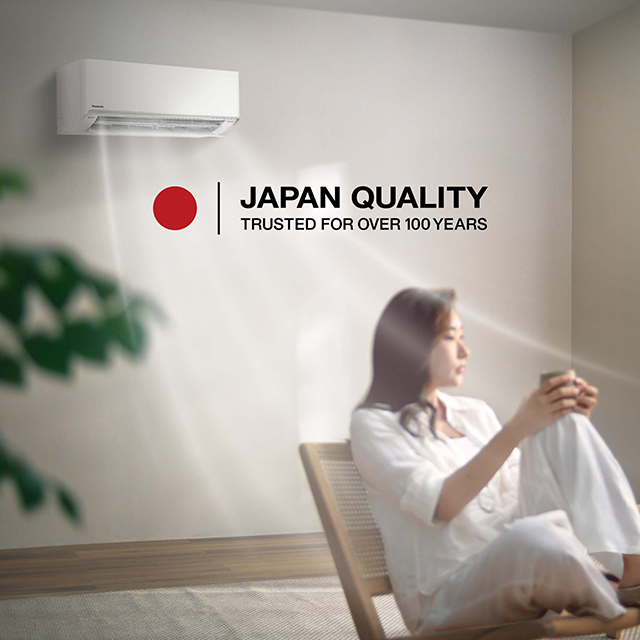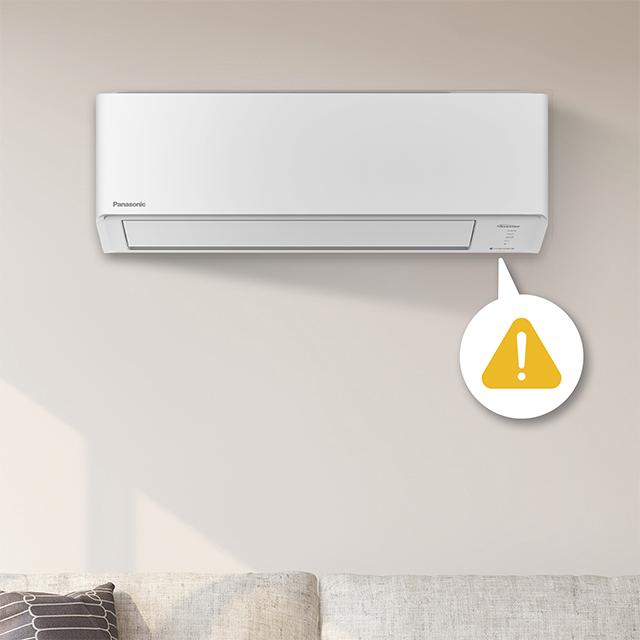Having a Baby? Here Are Tips on Maintaining Ideal
Humidity and Temperature for Your Home

Table of Contents:
- The ideal humidity for the baby's room
- The ideal temperature for the baby's room
- How to test the humidity in your room?
- How to increase the humidity in your room?
- How to lower the humidity in your room?
- What are good humidity and temperature levels for your house?
- Humidity and temperature levels in your house in summer for Southeast Asians
- A Panasonic air conditioner keeps your space clean and comfortable
Having a baby is a big responsibility for all parents and guardians.
Not only do you have to care for your baby’s physical and mental well-being, but you also have to improve your environment to provide the best for your baby.
One of the ways you can give the utmost care to your baby is by maintaining ideal humidity and temperature in your baby’s room and your home.
Maintaining an ideal humidity level in a baby's room is vital for several reasons.
At such an early age, babies are more sensitive to their environment. Ideal humidity is necessary to keep their respiratory system and skin healthy while providing overall comfort.
The ideal humidity for the baby's room
The ideal humidity level for babies around the world generally falls within a range of 30% and 50%1, according to the United States Environmental Protection Agency.
This range helps to ensure that the air is not too dry, which can cause respiratory problems and skin irritation, or too damp, which can promote the growth of mold and bacteria that are harmful to babies.
However, it's important to note that the ideal humidity level can vary depending on factors such as the climate, season, and individual baby's needs.
In hot and dry climates, such as some parts of the Middle East or Australia, a humidity level closer to 60%2 may be more suitable. Dry air can cause respiratory problems, nosebleeds, and dry skin for the baby, so it’s better to increase the humidity in your home.
Alternatively, in humid regions such as Southeast Asia or the Caribbean, a lower humidity level may be better to prevent mold and bacteria growth around your baby’s belongings.
As the ranges of humidity vary, the best thing you can do is consult with your pediatrician or a local expert to determine the most appropriate humidity level for your baby based on your specific location and situation.
The ideal temperature for the baby's room
The ideal temperature for your baby's room, according to SleepFoundation.org, typically ranges from 68°F (20°C) to 72°F (22.2°C)3.
In a hot and humid climate like the Middle East, a temperature of 71.6°F (22°C) to 75.2°F (24°C) is recommended, slightly higher than the international recommendation of 60.8°F (16°C) to 68°F (20°C) for cold climates4.
Aside from climate and individual needs, the seasons in your climate also affect the ideal temperature for your baby’s room.
The temperature range helps to ensure that your baby’s room is not too cold, which can cause discomfort and increase the risk of hypothermia, or too warm, which can cause dehydration and breathing problems.
You can also use a thermostat or a baby monitor with a temperature sensor to help you regulate the temperature in your baby's room so that it stays within a safe and comfortable range.
How to test the humidity in your room?
There is a simple way to test the humidity level in your room – all you need is a hygrometer. A hygrometer is an instrument that measures the amount of moisture or water vapour in the air.
Here’s what you need to do:
- Buy a hygrometer.
- Place the hygrometer in the room.
- Wait for the reading.
- Record the reading and adjust the humidity accordingly.
As your room's humidity will change depending on the time of the day, weather, and season, you should be making adjustments to maintain the ideal humidity level. The most efficient way to do so is to invest in a humidifier and a dehumidifier.

How to increase the humidity in your room?
If your hygrometer shows you reading too low in your baby’s room, it’s time to raise the humidity level. Here’s what you need to do to increase humidity in the room:
- As mentioned before, invest in a humidifier. A humidifier is a device that adds moisture to the air. They come in various sizes and may have additional features. You just need to fill the humidifier with water, turn it on, and let it release moist air into the room. Some humidifiers come with different levels of mist, so you can choose the right settings depending on your needs.
- Place a bowl of water in the room – evaporation can increase the humidity in a room. This is a simple, inexpensive way to increase humidity in your room. You can also add essential oils or herbs to the bowl of water to create a pleasant aroma.
- Use a plant mister – if you’re a plant owner, then you probably already own a plant mister. You can use the mister to occasionally spray water into the air to increase humidity. You can even keep plants in the room to help maintain the humidity as they release water vapour during transpiration.
- Open the windows – if the air outside is more humid than the air inside, opening the windows can increase the humidity in the room. However, if the air outside is dry, this method will not work.

How to lower the humidity in your room?
If you’re worried that the humidity in your room is too high and want to lower it, here are some effective ways to reduce humidity in a room:
- Use a dehumidifier – a dehumidifier removes moisture from the air. Just switch on the dehumidifier and let it remove the excess moisture from the air.
- Increase ventilation – open windows or use fans to increase the air circulation in the room. This can help to reduce the humidity level in the room as warm humid air in your room is replaced with fresh air from outdoors.
- Use an air conditioner – air conditioning can also help to reduce humidity in the room by cooling the air and removing moisture through its refrigerant.
- Avoid activities that produce moisture – activities like cooking, taking a long shower or bath, and drying clothes indoors can add moisture to the air. By identifying the activities that increase humidity and limiting them, you can reduce the amount of moisture that is trapped in your room or house.

What are good humidity and temperature levels for your house?
Good humidity and temperature levels vary depending on where you live, but there are some guidelines to help you maintain comfort and health indoors.
As a rule of thumb, indoor humidity for a baby should be around 30% and 50%, never going higher than 60%5. Some people might be comfortable with higher humidity levels, but high humidity can promote the growth of mold, bacteria, and dust mites, and low humidity can lead to dry skin, respiratory problems, and damage to wooden furniture and floors.
Keep in mind that young children, the elderly, and people with certain medical conditions may have different temperature and humidity needs.
It is recommended to use a programmable thermostat to regulate the temperature and humidity levels in your home and make adjustments based on your daily routine.
Humidity and temperature levels in your house in summer for Southeast Asians
In summer, humidity levels can increase due to the heat and humidity outside. High humidity makes the indoor environment uncomfortable, promotes the growth of mold and bacteria, and worsens allergies and respiratory problems. The general range of humidity for Southeast Asians, where it’s mainly summer all year round, should be between 40% and 50%6.
To control humidity levels in the house during the summer, use a dehumidifier to remove excess moisture from the air. It's important to keep the house well-ventilated by opening windows and doors when the outside air is cooler and less humid.
However, these can be adjusted based on personal comfort. Switching on ceiling fans and keeping your windows and doors open during cooler times of the day can help to circulate the air and lower the indoor temperature.
A Panasonic air conditioner keeps your space clean and comfortable
Creating an ideal environment for you and your baby requires effort. Apart from maintaining the ideal temperature and humidity in the baby’s room, you also need to ensure that it is a comfortable space with clean air. This is where products like Panasonic air conditioners come in – these conditioners are equipped with a unique technology known as nanoe™ X.
The nanoe™ X technology generates hydroxyl radicals contained in water to inhibit airborne and adhered pollutants such as germs, PM2.5, pollen, and allergens. As it is produced in a huge volume, it can quickly disperse and fill up the room, efficiently inhibiting pollutants. This is especially important for babies as their immune systems are not fully developed yet.
On top of that, depending on the air conditioner model you purchase, there are also additional benefits – an inverter for energy-saving, a smart app for convenient, out-of-home control, and a functional design for fast cooling.

Panasonic air conditioners, equipped with built-in humidity sensors, work together with iAUTO-X Function to provide the ideal sleep environment in bedrooms. They help to constantly achieve the right balance between temperature and humidity level, optimising your living environment.
With these useful tips to create the ideal humidity and temperature levels for your home coupled with Panasonic’s iAUTO-X, Humidity Sensor, and nanoe™ X technology, you can now rest easy knowing that your baby’s comfort and well-being are taken care of.
Learn more about nanoe™ X technology here.
1 https://www.epa.gov/mold/mold-course-chapter-2
2 https://iaq.works/humidity/indoor-humidity-level-why-is-the-40-60-range-ideal/
3 https://www.sleepfoundation.org/baby-sleep/best-room-temperature-for-sleeping-baby
4 https://gulfnews.com/parenting/child-health/baby-sleep-in-dubai-how-to-get-the-right-temperature-in-your-infantsroom-1.1586328365645
5 https://www.epa.gov/mold/mold-course-chapter-2
6 https://www.onehourheatandair.com/southeast-pa/about-us/blog/2019/december/what-is-the-ideal-humidity-in-winter-vs-summer-/
Related Products



















